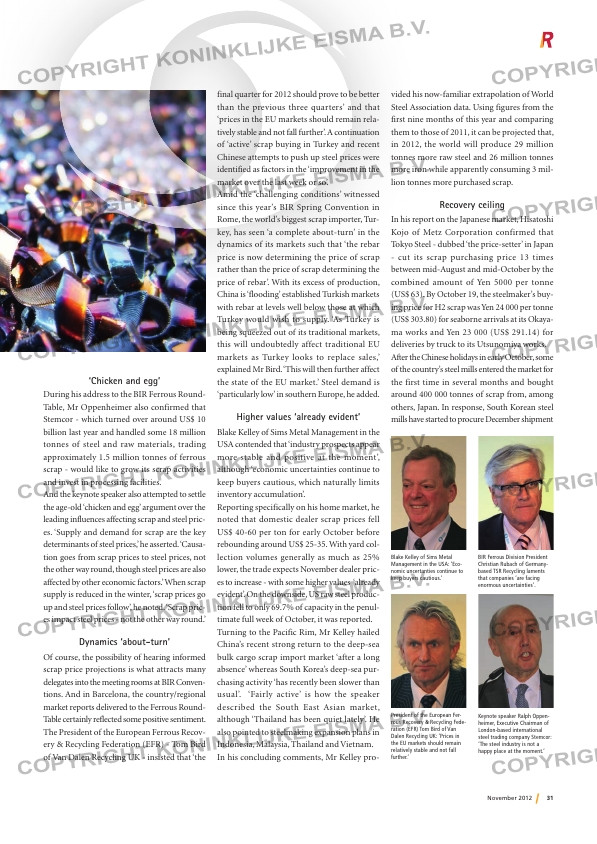Page 31 from: November 2012

31November 2012
‘Chicken and egg’
During his address to the BIR Ferrous Round-
Table, Mr Oppenheimer also confirmed that
Stemcor – which turned over around US$ 10
billion last year and handled some 18 million
tonnes of steel and raw materials, trading
approximately 1.5 million tonnes of ferrous
scrap – would like to grow its scrap activities
and invest in processing facilities.
And the keynote speaker also attempted to settle
the age-old ‘chicken and egg’ argument over the
leading influences affecting scrap and steel pric-
es. ‘Supply and demand for scrap are the key
determinants of steel prices,’ he asserted. ‘Causa-
tion goes from scrap prices to steel prices, not
the other way round, though steel prices are also
affected by other economic factors.’ When scrap
supply is reduced in the winter, ‘scrap prices go
up and steel prices follow’, he noted. ‘Scrap pric-
es impact steel prices – not the other way round.’
Dynamics ‘about-turn’
Of course, the possibility of hearing informed
scrap price projections is what attracts many
delegates into the meeting rooms at BIR Conven-
tions. And in Barcelona, the country/regional
market reports delivered to the Ferrous Round-
Table certainly reflected some positive sentiment.
The President of the European Ferrous Recov-
ery & Recycling Federation (EFR) – Tom Bird
of Van Dalen Recycling UK – insisted that ‘the
Keynote speaker Ralph Oppen-
heimer, Executive Chairman of
London-based international
steel trading company Stemcor:
‘The steel industry is not a
happy place at the moment.’
BIR Ferrous Division President
Christian Rubach of Germany-
based TSR Recycling laments
that companies ‘are facing
enormous uncertainties’.
President of the European Fer-
rous Recovery & Recycling Fede-
ration (EFR) Tom Bird of Van
Dalen Recycling UK: ‘Prices in
the EU markets should remain
relatively stable and not fall
further.’
Blake Kelley of Sims Metal
Management in the USA: ‘Eco-
nomic uncertanties continue to
keep buyers cautious.’
vided his now-familiar extrapolation of World
Steel Association data. Using figures from the
first nine months of this year and comparing
them to those of 2011, it can be projected that,
in 2012, the world will produce 29 million
tonnes more raw steel and 26 million tonnes
more iron while apparently consuming 3 mil-
lion tonnes more purchased scrap.
Recovery ceiling
In his report on the Japanese market, Hisatoshi
Kojo of Metz Corporation confirmed that
Tokyo Steel – dubbed ‘the price-setter’ in Japan
– cut its scrap purchasing price 13 times
between mid-August and mid-October by the
combined amount of Yen 5000 per tonne
(US$ 63). By October 19, the steelmaker’s buy-
ing price for H2 scrap was Yen 24 000 per tonne
(US$ 303.80) for seaborne arrivals at its Okaya-
ma works and Yen 23 000 (US$ 291.14) for
deliveries by truck to its Utsunomiya works.
After the Chinese holidays in early October, some
of the country’s steel mills entered the market for
the first time in several months and bought
around 400 000 tonnes of scrap from, among
others, Japan. In response, South Korean steel
mills have started to procure December shipment
final quarter for 2012 should prove to be better
than the previous three quarters’ and that
‘prices in the EU markets should remain rela-
tively stable and not fall further’. A continuation
of ‘active’ scrap buying in Turkey and recent
Chinese attempts to push up steel prices were
identified as factors in the ‘improvement in the
market over the last week or so’.
Amid the ‘challenging conditions’ witnessed
since this year’s BIR Spring Convention in
Rome, the world’s biggest scrap importer, Tur-
key, has seen ‘a complete about-turn’ in the
dynamics of its markets such that ‘the rebar
price is now determining the price of scrap
rather than the price of scrap determining the
price of rebar’. With its excess of production,
China is ‘flooding’ established Turkish markets
with rebar at levels well below those at which
Turkey would wish to supply. ‘As Turkey is
being squeezed out of its traditional markets,
this will undoubtedly affect traditional EU
markets as Turkey looks to replace sales,’
explained Mr Bird. ‘This will then further affect
the state of the EU market.’ Steel demand is
‘particularly low’ in southern Europe, he added.
Higher values ‘already evident’
Blake Kelley of Sims Metal Management in the
USA contended that ‘industry prospects appear
more stable and positive at the moment’,
although ‘economic uncertainties continue to
keep buyers cautious, which naturally limits
inventory accumulation’.
Reporting specifically on his home market, he
noted that domestic dealer scrap prices fell
US$ 40-60 per ton for early October before
rebounding around US$ 25-35. With yard col-
lection volumes generally as much as 25%
lower, the trade expects November dealer pric-
es to increase – with some higher values ‘already
evident’. On the downside, US raw steel produc-
tion fell to only 69.7% of capacity in the penul-
timate full week of October, it was reported.
Turning to the Pacific Rim, Mr Kelley hailed
China’s recent strong return to the deep-sea
bulk cargo scrap import market ‘after a long
absence’ whereas South Korea’s deep-sea pur-
chasing activity ‘has recently been slower than
usual’. ‘Fairly active’ is how the speaker
described the South East Asian market,
although ‘Thailand has been quiet lately’. He
also pointed to steelmaking expansion plans in
Indonesia, Malaysia, Thailand and Vietnam.
In his concluding comments, Mr Kelley pro-
RI-9_BIR-Ferrous.indd 31 09-11-12 14:23



